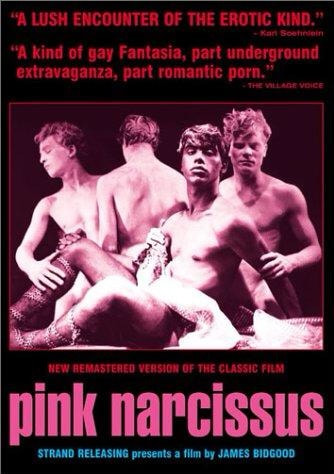|
I have been toying with this idea of writing more about LGBTQ+ films and TV for years now. In the 30 years of being an out proud queer man, I have been to countless film festivals, watched Blockbuster’s entire LGBT film offerings in the 90’s, probably twice. I feel like I have been riding alongside the journey of LGBTQ+ evolution when it comes to celluloid representation. This has been a road of diversions, detours and wanderings that has still to reach its final destination. I think it is why although I appreciate the normalisation of our community on the screen, I also hold queer content made for queer audiences very close to my heart.
So where do I begin? Do I begin from the first gay film I ever watched? What I have been watching recently? An old favourite? We’ll get to those in time, I promise. I thought the recent death of filmmaker/ artist James Bidgood of COVID complications might be a good starting point. A few days ago, hubby suggested watching Bidgood’s art house masterpiece, Pink Narcissus; which I had never seen. Now, given how many LGBTQ+ films I have watched in my lifetime, I should be ashamed of myself for not seeing it. Better late than never, right? The other reason why I hadn’t watched it before was probably because the film was released anonymously in 1971 after a fall out with the distributors and it would not be attached to Bidgood until the mid-90’s when writer Bruce Benderson, was researching what happened to the actors in the film. His book Bidgood was published in 1999 by Taschen and a restored version of Pink Narcissus was also released that same year. Pink Narcissus was shot entirely indoors on 8mm film during the years 1963-1970; mainly in Bidgood’s small apartment. Bidgood used a clever technique of bright colours over one another to obscure the nudity in the films negatives. This was also a way to protect himself from being prosecuted for breaking obscenity laws which were more severe for homosexuals at the time. The result is the kitsch almost Technicolor dream world which provides the setting for the films premise. We are taken on an erotic journey of a male prostitute’s sexual fantasies as he kills time between clients. For a modern audience, there is nothing risqué about what is being shown. Netflix probably has more hardcore content these days. In the context of its time though, Pink Narcissus was explosive. It is one of the first times that male nudity and expression is put into an art context and not pornography but still retains the eroticism that celebrates the beauty of the men and their attraction to one another in multiple scenarios. You’ll be hypnotised by Bobby Kendall’s striking features and movement as the centre character. Although we live in a world right now where hardcore images are freely available, there is a playfulness in the suggestiveness of scenes that the older I get, I find more appealing. So, even if you don’t “get” the film, you can still enjoy its voyeurism. It is not a film for everyone but it is one that stays with you and directly challenges our own current standards of male beauty and art. If you’re a fan of the work of Pierre et Gilles’ or David LaChapelle, you may want to see where their inspiration came from. James Bidgood started out taking photographs for male physique magazines in the 1950’s but found the work dull. In a New York Times interview he spoke about this. “There was no art,” Bidgood laments. “They were badly lit and uninteresting. Playboy had girls in furs, feathers and lights. They had faces like beautiful angels. I didn’t understand why boy pictures weren’t like that.” He would take that dissatisfaction and go on to change the way male nudity was photographed. Pictures would come alive as dreams in colour. Pink Narcissus, is a testament to his new vision and the playful hint of camp in his work is an addition to art that we should all be grateful for. You can watch Pink Narcissus on BFI player with a subscription in the UK and other streaming services.
0 Comments
|
AuthorJohn Lugo-Trebble considers this more of a space to engage personal reflections and memories with connections to music and film. Archives
November 2023
Categories |
Proudly powered by Weebly

 RSS Feed
RSS Feed